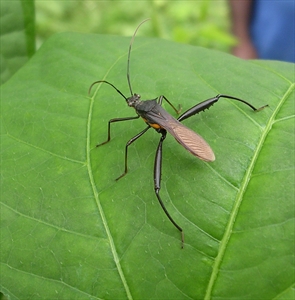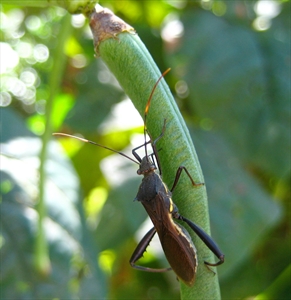Pod sucking bug
Pacific Pests, Pathogens, Weeds & Pesticides - Online edition
Pacific Pests, Pathogens, Weeds & Pesticides
Bean pod sucking bug (018)
Riptortus species; there are two species, Riptortus serripes and Riptortus linearis.
Asia, Oceania. Possibly, Australia, Riptortus linearis is recorded from Solomon Islands.
Legumes, such as long bean, French bean, soybean, and mung bean. Some species attack Macadamia and sorghum.
Eggs of Riptortus are laid on bean leaves and those of other plants; usually the eggs are laid singly. They hatch and the nymphs go through five stages. The nymphs are ant mimics (Photos 1&2), meaning they look like large black ants, presumably to protect them from predation. Adults are dark brown and about 20 mm long (Photos 3&4).
This is a major pest of beans. Both adult and nymphs "sting" the beans in the pods, feeding on the juices in them, so that the beans fail to mature. The pods turn brown, shrivel and die (Photo 5). Severe damage is caused to bean crops, long beans especially, in Pacific island countries.
Look for the large adult bugs on the leaves and under the leaves, 16-18 mm long; look for ant-like nymphs. Look closely for small holes and damaged, shriveled pods.
NATURAL ENEMIES
There are no reports of predators or parasitoids attacking Riptortus in Pacific island countries. However, the reduviids (assassin bugs), mantids (preying mantids), spiders and wasps that are known to attack Leptoglossus (see Fact Sheet no. 165 ) probably attack Riptortus eggs, and prey on nymphs.
CULTURAL CONTROL
Before planting:
- Do not plant crops of beans next to those that are already infested with the bug.
- Plant beans next to Bixa (Photo 6), a method recommended by a farmer on Malaita, Solomon Islands. Bixa is known as the lipstick tree. It has deep red, soft, seeds that children use to paint their faces, lips included. Bixa acts as a trap crop. As the seeds open large numbers of Riptortus are attracted to the seeds, preferring them to the seeds of beans, which suffer less damage as a consequence.
During growth:
- Handpick the insects. Do this in the early morning, as at other times of the day the insects are more likely to take flight.
After harvest
- Collect and burn as much of the crop as possible after harvest.
CHEMICAL CONTROL
If infestations reach levels where chemical control is necessary, use sprays of derris, pyrethrum or chilli (see Fact Sheet no. 56). If a commercial product is needed, use synthetic pyrethroids or malathion. But note, these pesticides will also kill the natural enemies.
--------------------
Note, derris (Derris species) contains rotenone, an insecticide, often used as a fish poison; it should be used with caution. The commercial derris insecticide is made from Derris elliptica.
____________________
When using a pesticide, always wear protective clothing and follow the instructions on the product label, such as dosage, timing of application, and pre-harvest interval. Recommendations will vary with the crop and system of cultivation. Expert advice on the most appropriate pesticides to use should always be sought from local agricultural authorities.
AUTHORS Helen Tsatsia & Grahame Jackson
Information from Pod-sucking bug - Riptortus serripes (2010) Insects and Spiders in Brisbane. (http://www.brisbaneinsects.com/brisbane_coreidbugs/PodSucking.htm); and CABI (2021) Riptortus linearis. Crop Protection Compendium. (https://www.cabi.org/cpc/datasheet/47644); and from Brown bean bug (2020) Business Queensland. Queensland Government. (https://www.business.qld.gov.au/industries/farms-fishing-forestry/agriculture/crop-growing/pests-field-crops/brown-bean-bug). Photos 1&2 Graham Teakle, Canberra, Australia.
Produced with support from the Australian Centre for International Agricultural Research under project PC/2010/090: Strengthening integrated crop management research in the Pacific Islands in support of sustainable intensification of high-value crop production, implemented by the University of Queensland and the Secretariat of the Pacific Community.









